| Method | Copper engraving |
| Artist | George Marshall after Antoine Desgodetz |
| Published | Desgodetz del. G. Marshall sculp. [I. and J. Taylor, London, 1795.] |
| Dimensions | Image 320 x 200 mm, Plate 340 x 215 mm, Sheet 550 x 375 mm |
| Notes |
Plate 3 of Chapter 19 from Marshall's The Ancient Buildings of Rome, an English edition of Desgodetz' Les edifices antiques de Rome dessinés et mesurés très exactement, depicting an architectural profile of the entablature and one of the column capitals of the Arcus Argentariorum in Rome, erroneously translated by Marshall as the 'Arch of the Goldsmiths.' The structure, which was probably a portico or the architrave of a monumental gateway rather than a triumphal arch as is often assumed, was set up in honour of Septimius Severus and his family by Rome's money-changers. The frieze and entablature are highly decorative, with multiple bands of acanthus patterns, beading, dentils, and egg and dart, while the square column capitals feature volutes of oak leaves, and curling acanthus patterns. Desgodetz' Les edifices antiques de Rome dessinés et mesurés très exactement was published by Coignard in Paris in 1682. Intended as an ambitious attempt to be the first precise description of ancient Roman architecture, the illustrative plates of Rome's main ancient buildings were accompanied by commentaries and meticulous architectural measurements. In so doing, it corrected the errors of Renaissance architects like Palladio, Serlio, and Labacco, proving conclusively that Roman architecture was far from the perfect adherence to a established canon that it had been assumed to have been. Instead, Desgodetz proved that Roman architecture was often flawed and inconsistent, with design responding more to necessity and availability of space than any official canon. The book became a seminal resource for French artists and architects and played a major role in stimulating artistic and academic interest in Rome's ancient structures during the following century. The work was reissued twice, in 1729 and 1779, and was a key inspiration for the young Robert Adam, who originally intended to revise the work before his famous journey to Split, Croatia. Adam undertook the project of republishing Desgotz's work but abandoned it a year later. The unrecorded architect and engraver George Marshall who resided in Kensington Palace took up the task of engraving new plates. It has been suggested that this project was commissioned and financed by George III as Marshall dedicated his work to him. Only Volume I was published in Marshall's lifetime. The publishers I. and J. Taylor printed the second volume along with a reissued first volume in 1795. Antoine Babuty Desgodetz (1653 - 1728) was a French artist and architect, known for his work on Roman architecture, Les edifices antiques de Rome dessinés et mesurés très exactement. Desgodetz had been sent to Rome by order of the King to help foster French artistic and architectural policy, and the illustrations and information he gathered formed the basis for the standardisation of French academic architecture. Condition: Minor time toning to edges of sheet. Binders creases to left edge of sheet. Large waterstain to bottom edge of sheet, not affecting plate. |
| Framing | unmounted |
| Price | £250.00 |
| Stock ID | 50594 |

